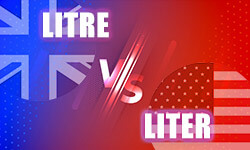
Ensuring logical and clear academic writing requires consistent language use. However, students sometimes run into difficulties distinguishing between British English vs. American English, particularly in spelling variations like “litre” or “liter.” This can be extremely confusing for people who are not native English speakers. For a better grasp of these language variations, continue reading.
Inhaltsverzeichnis
“Litre” or “liter”
The word “litre/liter” describes a unit of volume equal to 1,000 cubic centimeters or 1 cubic decimeter (about 1.0567 quarts) and functions as a noun, grammatically. “Litre” is the spelling used in British English, while “liter” is the spelling used in American English.

British English
litre

American English
liter
The spelling “litre” is more common in British English, while “liter” is the preferred spelling in American English. There is no variability or alternative spelling for each English variant in this case; each spelling corresponds to its respective English style.
Examples of using “litre” and “liter” as a noun
The following example sentences will illustrate the difference in the spelling of the noun “litre/liter” in British and American English.
- British English: Litre
- American English: Liter


FAQs
Both spellings are correct, but “litres” is the British spelling, and “liters” is the American spelling.
The only correct spelling in the UK is “litre.”
Canadians have a slight preference towards “litre,” however, they do use “liter” as well.
Yes, Americans use the measurement “liters” for volume. While the spelling differs, the actual unit of measurement is the same. Both “liters” and “litres” represent the volume equivalent to 1,000 cubic centimeters or 1 cubic decimeter. However, they also use the measurement “ounces.” One liter is approximately 33.814 fluid ounces.
- ✓ 3D live preview of your individual configuration
- ✓ Free express delivery for every single purchase
- ✓ Top-notch bindings with customised embossing

